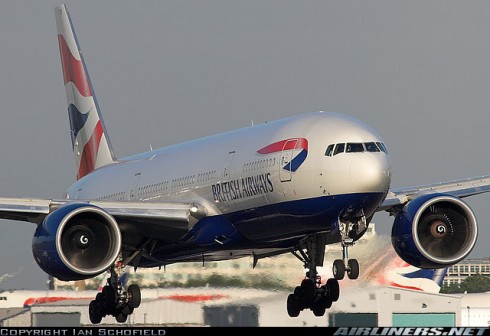Airline and Travel Blog
News and information about airlines and travel

British Airways Boeing 777 Incident at Heathrow Ai
January 17 2008, 9:45 PM
As most everyone knows by now, a British Airways Boeing 777-238ER landed short of runway 27L at Heathrow Airport at 1238GMT (about 438am Pacific Time) on Thursday. Of the 158 people on board (passengers and crew) there were only minor injuries as a result of the hard landing and slide evacuation.
Eyewitnesses and an initial account from the Captain seem to lead to a catastrophic power failure (what we call a dual engine failure) while the aircraft was on the approach to the airport. The pilots lots all power to the controls and the avionics. While pilots train for these situations and there is a specific checklist for this kind of event, it has never happened on a live flight and at the critical approach phase before landing.
Why the power failure occurred is something we will find out in the coming days as both black boxes are intact and will be recovered, so I will not speculate on what might have happened. What I will emphasize is what we know at this time about the actions of the crew which, in my opinion, were responsible for the successful landing of the aircraft.
You might ask yourself, why am I saying it was a successful landing. The answer is simple. The short answer is this: Any landing you can walk away from is a successful landing. While that is often used as a humorous line, there is more truth to that statement than fiction. Here is why I say this:
There is a "non-normal checklist" that deals with every possible situation that has been conceived that could happen, that gives the crew specific procedures in a specific order that they are to do in order to resolve the situation. In this case, the first thing is that one person flies the airplane and the other pilot solves the problem. So while the captain was trying to glide the airplane, the other pilot was starting the Auxiliary Power Unit or APU, which started from the battery. This provided power to the landing gear and would have returned some of the avionics to the pilots as they were trying to land.
The decision of the pilot was to keep the landing gear up unti the very last minute, because lowering the flaps and landing gear would create more drag, slowing the aircraft below its "stall speed" - the speed at which the aircraft could no longer fly.
The airplane was very low as it approached the airport, but once it got close enough to land, they lowered the landing gear. This caused the aircraft to stall and the airplane suddenly dropped onto the ground, but because the airplane was so low to the ground and flying so slow, the landing onboard felt like a very hard landing and really not much more. The airplane slid straight about 1200 feet and then as it reached the runway it slid to the right and came to a stop.
The cabin crew, realizing something was wrong, initiated an emergency evacuation and all eight slides were activated. All passengers and crew were off the aircraft within three minutes. By then, the fire services were already on scene shooting foam on the aircraft to keep down the possibility of any fire. The airplane was severely damaged, but the fuselage was in one piece. There were 18 people taken to the hospital, but injuries were minor.
As bad as this incident was, and as much as people are calling this a crash, I am not...I am calling it a landing incident. The reason is that the aircraft remained essentially in one piece and did not catch fire, there were no severe injuries and because the flight crew knew exactly what to do, there was a good result, even though the airplane is probably damaged beyond repair.
Also, what is crucially important is to pay attention to the safety instructions that are given at the beginning of each flight. Those safety instructions helped to keep the atmosphere in the cabin calm during the slide evacuation of the aircraft. So the lesson learned is to always pay attention to the safety annoucement every time that you step on an airplane (because each aircraft is different). You can also be reassured that the flight and cabin crews are so well trained that they are able to deal with any situation that may arise, with your safety as their primary responsibility. Today, British Airways has proven that in spades. In the coming days, we will find out what happened to the aircraft and at that time, I'll comment on that. Until then, we'll just say a prayer of thanks that no one was seriously hurt and give the BA crew a "Bravo" for a job well done.
Posted in Airline Blog
0 comments
| No comments yet. Be the first one to comment! |
Statistics
| Entries | 1 |
| Comments | 0 |
| Page views | 3,004 |
| Last update | Jan 17, 2008 |
